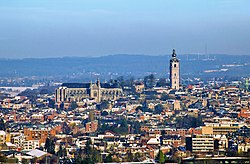
Back Mons Afrikaans منس Arabic مونس ARZ Mons AST Mons Azerbaijani Монс Byelorussian Монс BE-X-OLD Монс Bulgarian Mons (Wallonia) Breton Mons (Bèlgica) Catalan
Mons
Mont (Picard) Bergen (Dutch) | |
|---|---|
City and municipality | |
 Panorama of the old town | |
| Coordinates: 50°27′17″N 3°57′9″E / 50.45472°N 3.95250°E | |
| Country | |
| Community | French Community |
| Region | Wallonia |
| Province | Hainaut |
| Arrondissement | Mons |
| Government | |
| • Mayor | Nicolas Martin (PS) |
| • Governing party/ies | PS, Ecolo |
| Area | |
• Total | 147.56 km2 (56.97 sq mi) |
| Population (2018-01-01)[1] | |
• Total | 95,299 |
| • Density | 650/km2 (1,700/sq mi) |
| Postal codes | 7000-7034 |
| NIS code | 53053 |
| Area codes | 065 |
| Website | www.mons.be |
Mons (French: [mɔ̃s] ⓘ; German and Dutch: Bergen, Dutch pronunciation: [ˈbɛrɣə(n)] ⓘ; Walloon and Picard: Mont) is a city and municipality of Wallonia, and the capital of the province of Hainaut, Belgium.
Mons was made into a fortified city by Count Baldwin IV of Hainaut in the 12th century. The population grew quickly, trade flourished, and several commercial buildings were erected near the Grand-Place. In 1814, King William I of the Netherlands increased the fortifications, following the fall of the First French Empire. The Industrial Revolution and coal mining made Mons a centre of heavy industry. In 1830, Belgium gained its independence and the decision was made to dismantle the fortifications, allowing the creation of large boulevards and other urban projects. In 1914, Mons was the location of the Battle of Mons. The British were forced to retreat by a numerically superior German force and the town remained occupied by the Germans until its liberation by the Canadian Corps during the final days of the war. There are several memorial placards related to the WW1 battles.
Today, the city is an important university town and commercial centre. The main square is the centre of the old city. It is paved in the manner of old cities and is home to many cafes and restaurants, as well as the Town Hall and Belfry. It is forbidden to park in or drive through the centre. Together with the Czech city of Plzeň, Mons was the European Capital of Culture in 2015.
- ^ "Wettelijke Bevolking per gemeente op 1 januari 2018". Statbel. Retrieved 9 March 2019.




